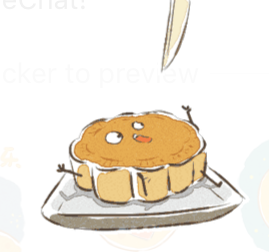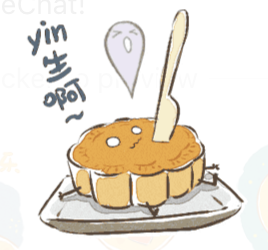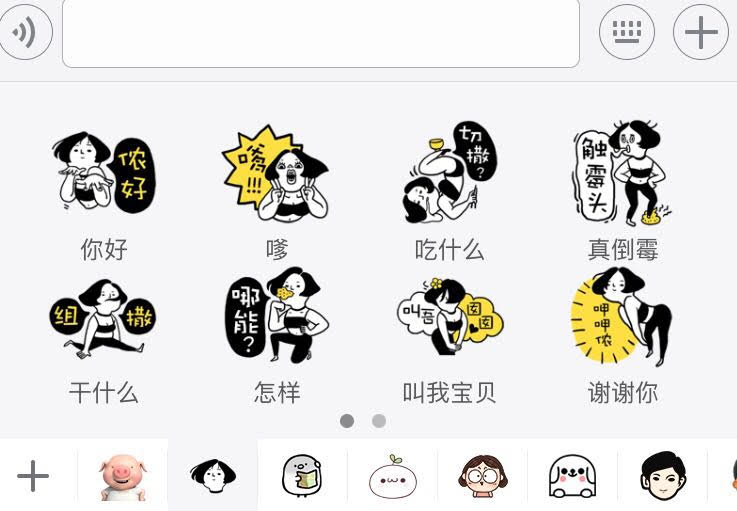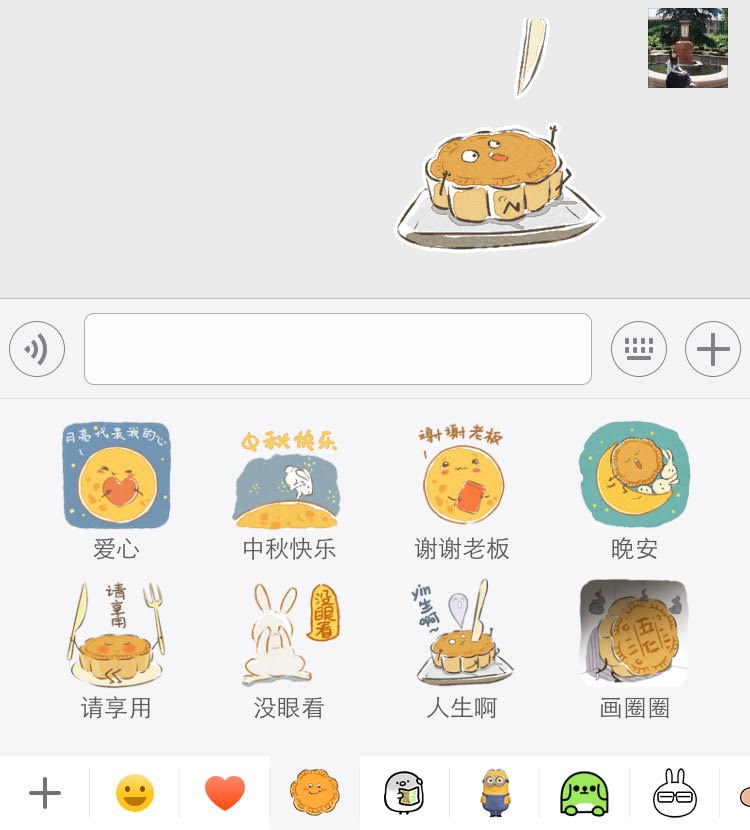C'est la vie ~
« previous post | next post »
Chris P sent in the following emojis from WeChat:
Chris comments:
I've recently de-expatriated back to the US after a decade and change in China/Taiwan/HK. During that time I've really enjoyed and learned a lot from reading your posts on Language Log. I notice you respond to a lot of reader questions, so I thought I'd finally pose one.
By way of background: one of the many habits I've yet to shuck off from my many years in mainland China is a reliance on WeChat as my primary means of social networking, even with other Westerners. This remained the case (at least for communicating with other Mandarin-speaking Westerners) when I joined the flood of expats moving from Shanghai to Hong Kong a couple years ago, even though in Hong Kong alternatives like Whatsapp don't have the latency issues they do inside the Great Firewall. I don't think my case is unusual — a preference for WeChat seems pretty typical within the peculiar diaspora of HK-based Mandarin-speaking Western millennials.
People cite all sorts of reasons for this, but if you press them after a few beers, they inevitably admit the reason their secret hearts cleave to WeChat before all other chat apps: the emoji. You wrote the other day about intentionally comic C-E ministrations in emoji, but there's a lot of other very fertile ground to cover there (some interesting ones about the Chinese school system, for instance, as well as one set of emoji rendering Cantonese expressions in Mandarin phonetic approximations — e.g. ding2gai2 presented as the reading for 點解). [VHM: In Cantonese that would be dim2gaai2, meaning "why", whereas in Mandarin it would be diǎnjiě and have no sensible meaning {"point solution"}.] I'm writing you today, though, about one emoji-mystery that has haunted me since the most recent Mid-Autumn Festival, when someone produced a lovely hand-drawn series of animated mooncake emoji, one of which included the phrase "yin生," whose meaning eludes me. I've made inquiries with a number of my (typically not very hip) Chinese friends, but to no avail, and other explorations have similarly been in vain. I recall that digraphia is one of your particular interests, so I'm turning to you as my last hope for some resolution before I'm forced to quit my job and devote myself full-time to decoding this word or phase. Above are two screen grabs that capture the general plot arc conveyed by the emoji in question.
Any idea what this poor fellow's final gasp is meant to convey?
The short and sweet (or quick and dirty) answer is that "yin" is a humorous mispronunciation of rén 人 ("human"), hence putting it all in characters would be "life, ah~" or, more literally and fully, "human life, ah~" (Modern Standard Mandarin [MSM] "rénshēng a ~ 人生啊~"). The locus classicus of this is probably the song about dōngběirén 東北人 ("northeasterners") — in northeastern topolects that would be "dongbeiyin" — all being "huó Léi Fēng 活雷锋" ("living Lei Fengs").
"Lei Feng: model soldier-citizen" (8/4/15)
The song: Dōngběirén dōu shì huó Léi Fēng 东北人都是活雷锋 ("Northeasterners are all living Lei Fengs")
The line: Ǎnmen nà gā dōu shì dōngběi yín 俺们那嘎都是东北yin ("We're all northeasterners") (Would someone please explain the function of the gā 嘎 vocable?)
At any rate, it's now pretty common in online slang.
One of my students from China wrote:
Upon seeing the emoji, I have laughed for totally 5 min!!! The mooncake is sighing "人生啊~". “yin” might be a topolect somewhere. But it is also a way to humorize the serious topic of "life". To me, the essence lies more in the "~". haha!
I find it fascinating that this student focuses so heavily on that small, unobtrusive "~". I should note that my students from mainland China, especially the girls, are very fond of this mark. To tell the truth, I'm not even sure what to call it. On top of an "n" or some other letters, it's a tilde, and I even know how to type it, at least on an "n" — ñ, see! But when it's on the same line as the words of a sentence, as in "rénshēng a ~ 人生啊~" ("human life, ah~"), I suppose it should be called a swung dash. I've often wanted to be able to type a swung dash, because it's part of the way I wish to communicate with my students from China, but I still haven't figured out how to do so. Apparently it's also widely used in Japanese typography, where it seems to be known as a "wave dash", and the Chinese may have picked it up from there.
In any event, since it made one of my students laugh for five minutes, the ~ in that short exclamation by the dying mooncake must be pregnant with ineffable meaning. I invite readers of this post to try to put into words what that little punctuation mark is conveying that is different from, for example, an exclamation point, which is how we'd usually end the French phrase "c'est la vie!" — the rough equivalent for "rénshēng a ~ 人生啊~" ("human life, ah~"). I have my own ideas about the nuances of ~ in this Chinese phrase and elsewhere in Chinese (as it is used by my students), but I'd be interested in what others think about the humble / mighty "~".
The student who laughed for five minutes at the emoji when I first sent it to her followed up:
And~~ Prof. Mair, the mooncake series is not only outdated, but also is only the tip of the iceberg in the Wechat emoji collection.
Attached please find series for Shanghainese, Cantonese, and Dongbei dialect. See if they amuse.
Cantonese:
Dongbei Dialect:
Shanghainese:
Back to the "yin" pronunciation of rén 人 ("human"). One of my students, who not only happens to be from the northeast herself, but who also just happens to be inordinately fond of "~", affirms that northeasterners pronounce rén 人 as "yin2" and remarks:
东北话 sounds 很土 and funny ("northeastern speech sounds very earthy / colloquial / country bumpkinish")
My own in-laws, who were from Shantung, pronounced rén 人 as "yin2".
Sometimes netizens will write yínshēng 银生 (lit., "silver life") or yínshēng 淫生 (lit., "licentious / wanton / loose / excessive / lewd / obscene / kinky life") to capture the northeastern sound while at the same time providing additional irony.
One student told me that she and her friends often use nonstandard Mandarin to màiméng 卖萌 ("act / be / play cute").
A native Pekingese recapitulates the meaning of the the pair of emojis pictured at the beginning of this post:
In the first picture, the anthropomorphized moon-cake is surprised to see that he is going to be "slaughtered" by a knife. In the second picture, he is slaughtered with his ghost above him.
The meaning of these two pictures may be related to the chéngyǔ 成语 ("set phrase"): "rén wéi dāo zǔ,wǒ wéi yú ròu 人为刀俎, 我为鱼肉" ("to be the meat on somebody's chopping block"). The destiny of the moon-cake is to be eaten. Moreover, moon-cake is a special type of diǎnxīn 点心 ("dessert; pastry; snack" [Cant. dim sum]). Diǎnxīn 点心 in Běijīnghuà 北京话 ("Pekingese") means a lame duck (fèiwù 废物, méi yòng de rén 没用的人). So maybe this picture is an irony of a useless man facing his inevitable fate.
C'est la vie ~
[Thanks to Brendan O'Kane, Xiuyuan Mi, Yixue Yang, Rebecca Fu, Jing Wen, and Yiran Xiao]
Postscript for those who want to see the whole mooncake series:






Ben Zimmer said,
November 15, 2015 @ 11:47 am
For a different development in the semiotics of the tilde, see: "The Hidden Language Of The ~Tilde~" (Joseph Bernstein, Buzzfeed, Jan. 5, 2015).
Francisco said,
November 15, 2015 @ 3:28 pm
"I've often wanted to be able to type a swung dash, because it's part of the way I wish to communicate with my students from China, but I still haven't figured out how to do so."
The inline tilde should be available in the math character set of word processing programs.
MattF said,
November 15, 2015 @ 3:49 pm
When I was in graduate school, I had a professor who made a distinction between a 'tilde' and a 'twiddle', a tilde that wiggles the 'other way'. He would use it in mathematical formulas to distinguish two variables that were paired as polar opposites. It made sense at the time.
Adrian said,
November 15, 2015 @ 4:49 pm
What a strange word 啊 is. I thought it said "obot"!
Richard W said,
November 15, 2015 @ 5:06 pm
"I still haven't figured out how to [type a swung dash]."
In Wenlin, just type a tilde "~", then press the conversion key (the same one you would use to convert "rensheng" to 人生).
In Google Translate, using the Chinese IME, just press the "tilde" key on your keyboard, and the swung dash ~ will appear directly in the text box.
Regarding uses of the swung dash, it is, of course, also commonly used in Chinese dictionaries in place of a headword in example sentences:
e.g. 煉製
提煉製造。[例]~汽油
Rubrick said,
November 15, 2015 @ 5:58 pm
"Point solution" could be perfectly sensible in a mathematical context, though I'm guessing the meanings of "point" and/or "solution" are the wrong ones here (I know no Cantonese).
Victor Mair said,
November 15, 2015 @ 6:13 pm
@Rubrick
Cantonese dim2gaai2 means "why". The characters with which it is written ("point solution") bear no relationship to that meaning. This is a phenomenon that I have pointed out countless times on Language Log.
Victor Mair said,
November 15, 2015 @ 6:26 pm
@Adrian
I love your reading 啊 as "obot".
You might be interested to know that 阿 by itself would also be pronounced "ah" and have similar functions as a particle as 啊, but that the addition of the "mouth" radical on the left side of the latter character is there to emphasize its function as a particle having a sound but lacking overt semantic content.
Sally said,
November 15, 2015 @ 7:56 pm
A theory for the tilde: is it possible that ~ visually "draws out" the expression? In the context of 人生啊~ the phrase ends on a dainty little exhalation (ren sheng aaaah …!). The effect is, I think, a facetious, playful world-weariness.
liuyao said,
November 15, 2015 @ 10:05 pm
You'd need to be constantly surfing the Chinese "intranet" to instantly get the new vocabulary coming out every day.
I'm too at a loss at the widely used tilde (indeed most by girls). It may have the effect of elongating the last syllable, or even making it undulate somewhat (hence guys avoid using it as that's too girly).
Per your question regarding gā 嘎 in dongbei hua, that's the word for place, and may also be gāda 嘎嗒. Dongbei hua has attained its comical status, and wide intelligibility, mostly due to the skit comedy on Spring Festival gala on CCTV each year (more than the Lei Feng song).
Victor Mair said,
November 15, 2015 @ 10:53 pm
@liuyao
Does what you said about gā 嘎 explain the nà gā 那嘎 in the sentence I quoted above?
liuyao said,
November 15, 2015 @ 11:34 pm
I believe so. You may safely replace 嘎 with 地方 to make it Modern Standard Mandarin. It may have come from the gā in 几角旮旯.
Jean-Michel said,
November 16, 2015 @ 5:05 am
In Qingdao (where 人 is also pronounced yin in the local dialect, and also frequently written as 银 to represent the non-standard pronunciation), there are two middle schools called 超银中学 Chāo Yín Zhòngxué, which prompts a lot of amusement among those for whom 超银 = 超人 = "surpassing human," or more idiomatically, "Superman." I doubt this was an accident and the schools themselves sometime exploit the association, as in this article (“超银的老师是‘超人’”, or "Chao Yin's teachers are 'supermen'").
wasun said,
November 16, 2015 @ 10:05 am
Then there's 淫(yin) lewdness, and the tongue in cheek internet slang “你真是个好淫” (you are such a nice guy)
Yuval said,
November 16, 2015 @ 12:45 pm
So basically are you saying the free-ranging tilde should be used in Chinese subtitles for Monthy Python's The Castle of Aaaaaargh?
If so, I'd consider calling it CoA sign. ;-)
https://m.youtube.com/watch?v=XiT_5cr3tYI
Calvin said,
November 16, 2015 @ 4:41 pm
@Victor Mair, in the instance of "點解" in Cantonese, "點" means "how/what", not "point". It is roughly equivalent to "怎樣" in MSM. And "解" is short for "解釋" (explain), not "解決" (solution). Hence "點解" means "how to explain", or just "why".
Some examples of such usage of "點" in Cantonese:
點做: How to do
你最近點: How are you recently?
你想點: What do you want?
Victor Mair said,
November 16, 2015 @ 8:17 pm
@Calvin
That's the point I was trying to make.
January First-of-May said,
November 17, 2015 @ 8:14 am
@liuyao
"I'm too at a loss at the widely used tilde (indeed most by girls). It may have the effect of elongating the last syllable, or even making it undulate somewhat (hence guys avoid using it as that's too girly)."
While I'm not a native English speaker, the above is pretty much my perception of the meaning of the sentence-final tilde as used in (online) written English (apparently borrowed from Japanese use in anime and/or manga).
To be more precise, I've seen it used mostly in speech by female characters (some of it – perhaps most – written by male authors).
Eidolon said,
November 17, 2015 @ 2:45 pm
The use of tilde at the end of sentences is popular across much of the internet, not just East Asia. I've seen it used frequently by English speakers on forums, blogs, etc. Quora has an explanation in the form of: :https://www.quora.com/Punctuation/What-is-the-cultural-impetus-for-ending-text-messages-with-a-tilde but I'm not sure how accurate it is. The Japanese wave dash is frequently cited as the beginning of the use, but there are actually two usages that I'm aware of. One is similar to the Chinese usage in denoting a "cute"/"playful" expression and is mainly used by, I suppose, people familiar with East Asian cultures. But the other is to denote sarcasm eg as an irony punctuation, https://en.wikipedia.org/wiki/Irony_punctuation. This usage doesn't look to have come from the Japanese but instead, from the English internet.
Eidolon said,
November 17, 2015 @ 2:54 pm
Just as an addition to what I said above, the use of tilde to stand for sarcasm was, from what I understand, first proposed by Tara Liloia in 2001:
"What I am proposing is a punctuation mark that clears up all confusion about sarcastic remarks for the reader. The closest thing to a sarcasm mark is the winking smiley—and he isn’t really a professional tool. You can’t write a missive to a business associate with little cutesy ASCII faces in it. It’s just not done. […] My solution is the tilde. ~"
It didn't stick then, but looks to have become increasingly popular now.